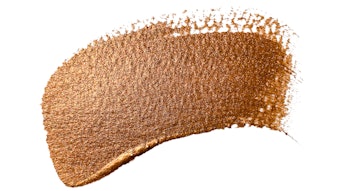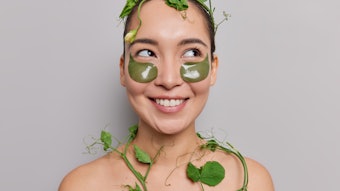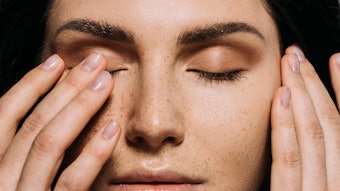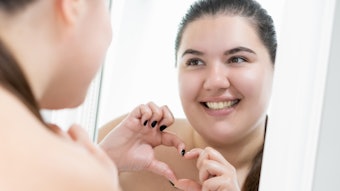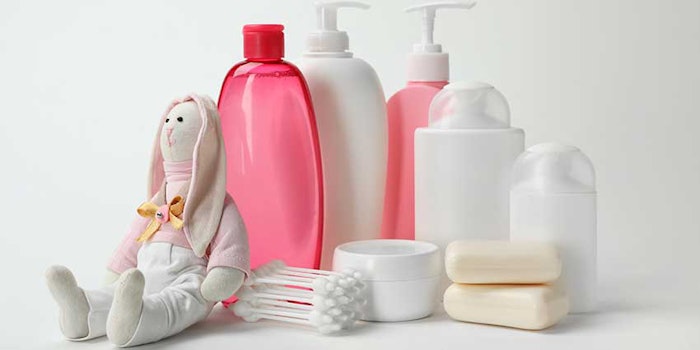
The baby care segment of the personal care market offers a limited variety of products that are mostly focused on cleansing and moisturization. Cleansing is provided through mild, liquid surfactant-based systems in products such as cleansing wipes and mild shampoos, while moisturization is addressed by re-fatting agents that provide a protective coating to skin. Beyond the skin care basics, diaper rash characterized by irritation and inflammation is another common concern, as are yeast infections, typically Candida albicans, followed by skin dermatitis. In addition, since mothers are linked closely with their babies, expectant and new moms tend to use similar products to their babies’.
Key Baby Care Components
It is well-known that baby’s skin is more delicate than mature human skin—especially in newborns, whose skin is still developing and has a higher degree of permeation for skin irritants. Scientific studies related to infant skin and ingredient reactions are minimal and mostly based on studies performed in the 1970s and 1980s. Thus, a cautionary approach is advisable when formulating baby care products, in order to minimize skin irritation.
Cautionary ingredients: Obviously, ingredients that have not been tested on infant skin for potential sensitization, allergic reactions and skin absorption into the bloodstream should be omitted from baby care formulas. Examples include harsh detergents such as sodium lauryl sulfate, strong or excessive amounts of preservatives, de-fatting agents, PEG-containing additives and fragrances. These ingredients are by no means hazardous and should not necessarily be omitted from adult skin care products, but it is highly recommended that these ingredients and the formulas containing them be tested for use on infant skin. Further, it should be noted that although natural preservatives may be beneficial to baby care products, care should be taken when using them as their safety on infant skin may not have been thoroughly investigated.
Suitable components: Infant skin requires refatting and barrier protection, thus moisturizers, humectants and emollients are good options for baby skin care formulas. In particular, dimethicone is a safe and effective ingredient. In fact, the US Food and Drug Administration issued a monograph listing a number of ingredients allowed for skin protection drug claims4 that includes dimethicone 1–30% (350–1000 cst), glycerin 20–45%, allantoin 0.5–2.0% and petrolatum 30–100%.
In general, any emollient with the ability to prevent high transepidermal water loss (TEWL) and prevent low conductance would be suitable as long as it is not classified as a comedone producer or noted for skin sensitization. Examples of such emollients are C30–45 dimethicone, myristyl behenate, cocoa butter, mango butter and shea butter.
Recent Patents
Recent patents related to baby care include antimicrobial peptides to prevent skin contamination, a bamboo-based antiseptic and stimulation of the Vernix caseosa, which are described here.
Stimulating properties of Vernix caseosa: This patent discloses a composition and method for producing the composition that reportedly simulates the beneficial properties of native Vernix caseosa (vernix), such as hydration and cleansing.5 The composition is comprised of hydrated synthetic cells in a lipid matrix that provide rheological properties substantially similar to those of vernix. In addition the composition may contain proteins, and in one embodiment, it contains cubosomes/water with up to 30% protein and approximately 5–30% lipid. The composition may be used to cleanse newborn skin, compromised skin surfaces, normal skin and for other applications to support hydration and barrier function.
Bamboo/oil skin antiseptic: Aspects of this invention involve the ability of bamboo fibers and isolated essential oils to produce biodegradable and sustainable products with exceptional antiseptic and aromatic properties.6 Accordingly, in some embodiments, the invention provides compositions including a bamboo fiber and an isolated essential oil. This patent application exemplifies the use of natural substrates that do not irritate skin and natural oils that have been tested for skin sensitization.
Antimicrobial peptide: Disclosed in this patent are peptides demonstrating beneficial antimicrobial activity, desired hemolysis levels and advantageous therapeutic indices against various microorganisms, especially Pseudomonas aeruginosa, Acinetobacter baumannii and Staphylococcus aureus.7 Also provided are methods to control microbial growth and pharmaceutical compositions to treat or prevent microbial infections.
The peptides disclosed utilize a structure-based modification of the antimicrobial peptide D1—with single D-/L-amino acid substitutions or charged residue substitutions in or near the center of the peptide on the nonpolar or polar face—or peptides with one or more amino acids in the D configuration; and peptides with all amino acids in the D configuration. The modified peptide analogs described can demonstrate one or more properties such as improved antimicrobial activity, specificity and resistance to degradation. The compositions disclosed are useful as broad-spectrum antibiotics. Since baby skin has the potential for microbial contamination, the use of antimicrobial agents that are more natural and more aligned to skin provides interesting options for formulators.
Recent Commercial Product Launches
As noted, newborn and baby personal care products are relatively narrow in scope since they are positioned by marketers primarily for cleansing and skin protection. Following is a cross section of a few recent launches in this category, including cleansing wipes, skin moisturizers and hair cleansers, to exemplify the typical products marketed to infants and their mothers. Included with each is the complete list of ingredients along with their approximate concentrations and functions.
fL Faberlic Caramel Myagkiy Shampun’ I Gel’ Dlya Dusha (Soft Hair and Body Wash): The hair and body wash shown in Figure 1 is formulated to cleanse delicate baby hair and skin. The product has a soft cleansing base that forms gentle foam (see Table 1). It contains milk caramel—a blend of caramel, milk, glycerin and surfactants—and apple amino acids to actively moisturize baby skin. D-panthenol and oat protein are also included to lend shine and manageability to the hair.
Johnson’s Hand and Face Wipes: The wipes pictured in Figure 2 were created to gently and effectively remove 95% of dirt and germs from a baby’s hands and face. They are made with the company’s “No More Tears” formula, which includes ingredients that are mild to infants’ eyes (see Table 2). The wipes are free from alcohol to reduce potential de-fatting of skin or skin irritation.
Urtebaby Natural Oats Baby Maize Powder: This Natural Oats range is formulated with natural oat extract (see Table 3), a noted skin-soothing agent, to reduce irritation that could lead to skin reddening or inflammation. Specifically, the Baby Maize Powder, shown in Figure 3, contains oat in addition to cornstarch to mildly remove excess moisture on delicate baby skin for a lasting dry and comfortable finish. This powder can also be used during pregnancy.
Essential Care Organic Nipple Balm: The balm shown in Figure 4, part of the company’s Mum and Baby line, is formulated with coconut and extra virgin olive oils along with shea butter and calendula to sooth and protect mothers’ nipples from cracks and soreness (see Table 4). The balm can also be massaged into the perineum during the last few weeks of pregnancy. The product is 100% food-grade, is safe for breast-feeding and is suitable for vegetarians; in addition, it is free from parabens, petrochemicals, synthetic colors and fragrances, and has not been tested on animals.
Mommy Care Organic Baby Lotion: This 100% natural lotion, pictured in Figure 5, is said to be quickly absorbed and is formulated with calendula to soothe, and olive and almond oil to protect baby skin (see Table 5).
Formulator Beware
Developing baby care products requires a careful understanding of the raw materials used and their potential effects on infant skin. The market is ripe for products based on a renewable, naturally derived or inspired resources; for instance, synthetic vernix may have a place in this category. Vernix, a lipid-rich naturally occurring skin protectant composed of sebum, epidermal lipids, desquamated epithelial cells, free fatty acids and ceramides,8, 9 acts as a protective bio-film by protecting the fetus during the last trimester. It comprises approximately 10% lipids, 10% proteins and 80% volatile fraction by weight; thus, products combining lipids and proteins similar to those found in vernix will likely begin to appear on the market. One possible combination is squalene (9%), aliphatic waxes (12%), sterol esters (33%), diesters (7%), triglycerides (26%), free sterols (9%) and other lipids (4%). Other ingredients to consider would be epidermally derived proteins such as keratin and filaggrin.
The stimulation of antimicrobial peptides would also enhance and/or restore natural immunity in the skin of newborn infants and children, whose immunity is generally deficient, as well as in adult and mature skin. This stimulation would thus make it possible to supplement the skin’s passive defense system and accelerate healing.
References
Send e-mail to [email protected].
1. C Lund, Prevention and management of infant skin breakdown, Nurs Clin North Am 34(4) 907–920, vii. (Dec 1999)
2. GN Stamatasa, J de Sterkeb, M Hauserc, O von Stettenc and A van der Polb, Lipid uptake and skin occlusion following topical application of oils on adult and infant skin, J Dermat Sci 50(2) 135–142 (May 2008)
3. VA Harpin and N Rutter, Barrier properties of the newborn infant’s skin, J Pediatr 102(3) 419–425 (1983)
4. 21 CFR PART 347.10, Skin Protectant Drug Products For Over-The-Counter Human Use, US Food and Drug Administration, http://www.accessdata.fda.gov/scripts/cdrh/cfdocs/cfcfr/CFRSearch.cfm?CFRPart=347&showFR=1&subpartNode=21:5.0.1.1.21.3 (Accessed Jun 1, 2011)
5. US Patent 7,807,188, Simulated vernix compositions for skin cleansing and other applications, SB Hoath, WL Pickens and MO Visscher, assigned to the Children’s Hospital Medical Center (Oct 5, 2010)
6. US Patent Application 20110017631, Bamboo fiber baby wipes, S Sheasley, assigned to BumBoosa LLC (Jan 27, 2011)
7. US Patent Application 20110028386, Antimicrobial Peptides, RS Hodges and Z Jiang (Feb 3, 2011)
8. Schreiner Hoeger et al, Epidermal barrier lipids in human Vernix caseosa: Corresponding ceramide pattern in vernix and fetal skin, Br J Dermatol 146(2) 194–201 (2002)
9. MI Bautista et al, Characterization of Vernix caseosa as a natural biofilm: Comparison to standard oil-based ointments, Pediatr Dermatol, 17(4) 253–60 (Jul–Aug 2000)


